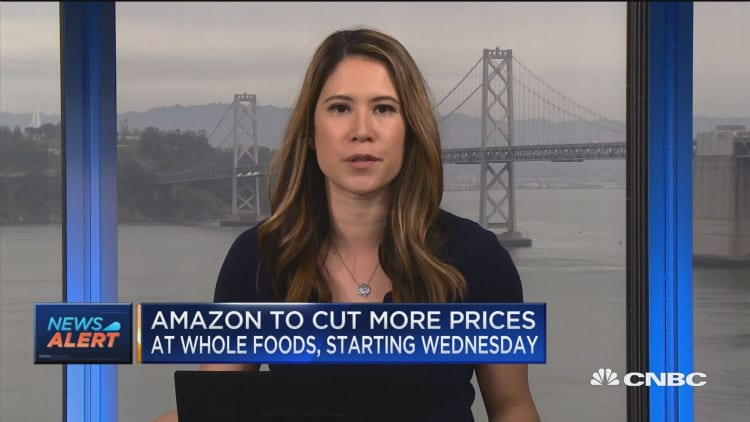Whole Foods plans to slash prices on Wednesday, and that's a sign of the "cutthroat competitive landscape in food retailing," Moody's analyst Charlie O'Shea said Tuesday.
The grocer announced on Monday it will discount hundreds of items in its first major round of price cuts since November 2017, shortly after it was acquired by Amazon. Customers will save an average of 20 percent on the new reduced-price items, which will focus on produce, such as greens, tomatoes and tropical fruits, the grocer said. It is also doubling the number of exclusive deals it offers Amazon Prime members.
"Amazon's plans to cut prices on hundreds of products at Whole Foods, as well as offer expanded benefits to its Prime members, recognizes the cutthroat competitive landscape in food retailing, led by Walmart's relentless push to continue expanding its leading market position in the segment," said O'Shea.
In the past two decades, growth among large grocery chains in North America has been just 2 percent, while commodity and labor costs have been increasing, according to a recent report by consulting firm McKinsey. The firm anticipates that by 2026, $200 billion to $700 billion in traditional grocery sales could move toward other formats and channels, like convenience stores and discounters. As retailers lose traffic to Amazon for goods that shoppers can easily buy online, everyone from Kohl's to Walgreen's is adding more fresh food to draw shoppers in.
As result of this pressure, major U.S. grocers increasingly have to fight on all three fronts: price, service and technology.
Online food and grocery sales in the U.S. are forecast by IGD to reach $59.5 billion in 2023, up from $23.9 billion last year. That would push e-commerce sales to account for 3.5 percent of the total market, compared with about 1.6 percent today.
Walmart, already known for its low prices, has been adding delivery services to its roster, as well as experimenting with driverless cars. U.S. e-commerce chief Marc Lore recently said Walmart will find a way to one day put groceries right into customers' refrigerators.
Walmart delivered its own announcement to the market on Tuesday, saying shoppers on Google Assistant will soon be able to add products to their Walmart Grocery cart. The move marks a direct counter to Amazon's push to have users of its Alexa voice assistant shop for Whole Foods products.
As Walmart and Amazon step up their investment, other middle-size grocers can expect to be squeezed, said O'Shea. These retailers don't have the funds to invest in the technology or pricing to compete against their new larger competitors. Last year, there was a string of bankruptcies of U.S. grocers, including Winn-Dixie parent Southeastern Grocers.
"While Walmart has the wherewithal and willingness to meet the Amazon threat in food, as well as a different customer demographic, other food retailers will continue to feel the pressure from the ongoing and now-escalating battle between Amazon and Walmart, with this battle continuing to impact almost all retail categories," O'Shea said.



